2020-2021学年人教版七年级下册英语Unit10学案
_Unit 10 SectionB 1a-1d教案 2020-2021学年人教版英语七年级下册
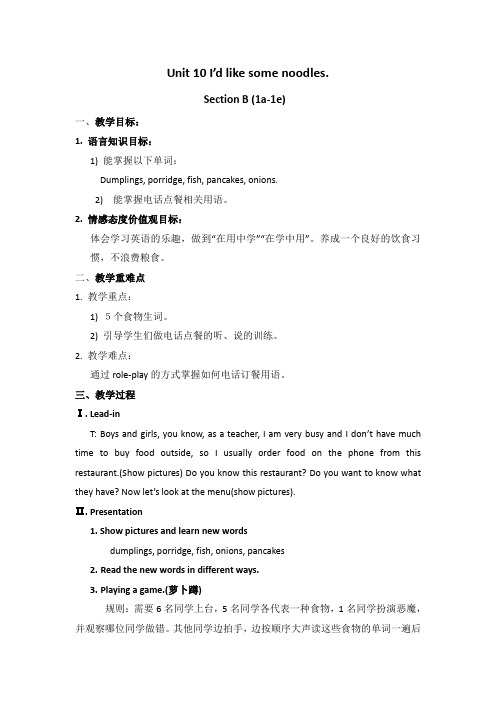
Unit 10 I’d like some noodles.Section B (1a-1e)一、教学目标:1. 语言知识目标:1) 能掌握以下单词:Dumplings, porridge, fish, pancakes, onions.2)能掌握电话点餐相关用语。
2. 情感态度价值观目标:体会学习英语的乐趣,做到“在用中学”“在学中用”。
养成一个良好的饮食习惯,不浪费粮食。
二、教学重难点1. 教学重点:1) 5个食物生词。
2) 引导学生们做电话点餐的听、说的训练。
2. 教学难点:通过role-play的方式掌握如何电话订餐用语。
三、教学过程Ⅰ. Lead-inT: Boys and girls, you know, as a teacher, I am very busy and I don’t have much time to buy food outside, so I usually order food on the phone from this restaurant.(Show pictures) Do you know this restaurant? Do you want to know what they have? Now let’s look at the menu(show pictures).Ⅱ. Presentation1. Show pictures and learn new wordsdumplings, porridge, fish, onions, pancakes2.Read the new words in different ways.3.Playing a game.(萝卜蹲)规则:需要6名同学上台,5名同学各代表一种食物,1名同学扮演恶魔,并观察哪位同学做错。
其他同学边拍手,边按顺序大声读这些食物的单词一遍后问:What would you like? 老师所点菜的同学蹲下,做错的被恶魔吃掉,看哪位同学可以坚持到最后。
Unit 10 SectionB 2a-2c教案2020-2021学年人教版英语七年级下册
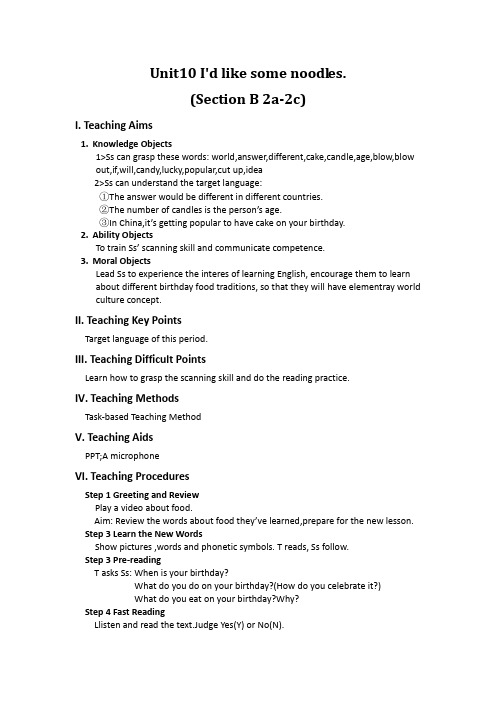
Unit10 I'd like some noodl es.(Section B 2a-2c)I. Teaching Aims1.Knowledge Objects1>Ss can grasp these words: world,answer,different,cake,candle,age,blow,blowout,if,will,candy,lucky,popular,cut up,idea2>Ss can understand the target language:①The answer would be different in different countries.②The number of candles is the person’s age.③In China,it’s getting popular to have cake on your birthday.2.Ability ObjectsTo train Ss’ scanning skill and communicate competence.3.Moral ObjectsLead Ss to experience the interes of learning English, encourage them to learn about different birthday food traditions, so that they will have elementray world culture concept.II. Teaching Key PointsTarget language of this period.III. Teaching Difficult PointsLearn how to grasp the scanning skill and do the reading practice.IV. Teaching MethodsTask-based Teaching MethodV. Teaching AidsPPT;A microphoneVI. Teaching ProceduresStep 1 Greeting and ReviewPlay a video about food.Aim: Review the words about food they’ve learned,prepare for the new lesson. Step 3 Learn the New WordsShow pictures ,words and phonetic symbols. T reads, Ss follow.Step 3 Pre-readingT asks Ss: When is your birthday?What do you do on your birthday?(How do you celebrate it?)What do you eat on your birthday?Why?Step 4 Fast ReadingLlisten and read the text.Judge Yes(Y) or No(N).(Use the skimming skill to get the main odea of this text,then use the scanning skill when you see the red words in the sentences.)Step 5 Careful Reading(2b)Read the article about food traditions and complete the chart.(Give Ss the reading skill directions before reading.)Step 6 2cRead the text again and answer the questions.(Give Ss the reading skill directions before reading.)Step 7 Words and ExpressionsSimple explanation for some expressions of this text.Step 8 SummaryIn this lesson, we’ve learnd : 1.Two reading skills:Skimming &scanning2.Some words and expressions .Let’s read it together.3.We should never forget our parents’ selflesslove,so let’s do something for them.For example,remember their birthdays and say “Happybirthday!” to them or help them do somechore.(Moral object)Step 9 Homework1.Read and recite part of the text.2.Make sentences by using the expressions we’ve just learnd.3.Finish your homework on your exercise books.Step 10 ReflectionThis lesson is excellent in teaching Ss how to do reading task (skimming & scannning skill),but the teacher didn’t give enough time to the students,which may let the students can’t grasp the reading skills very well.As for the explanation, it’s not so necessary to translate the text sentence by sentence.As far as I’m concerned,it would be better to give some time to Ss,and let them read the text for one to two times in this lesson.。
人教版七年级英语下册Unit10(阅读课)教学设计
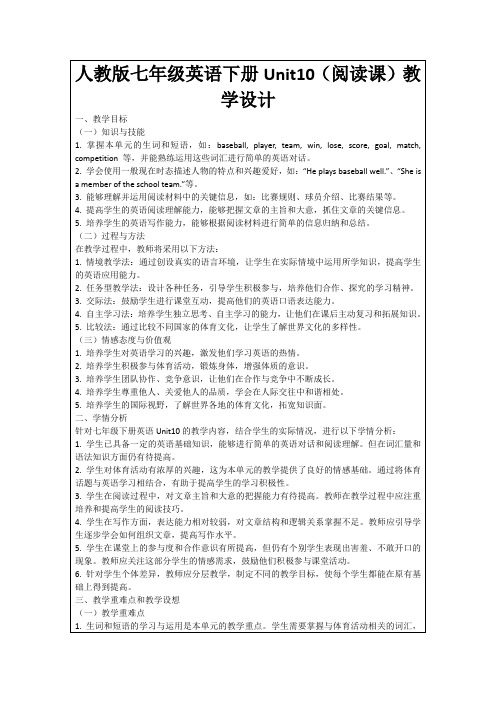
(一)导入新课(500字)
1.教师通过向学生展示一组体育活动的图片,如篮球、足球、乒乓球等,引导学生回顾已学的相关词汇,为新课的学习做好铺垫。
2.邀请学生分享他们最喜欢的体育项目,并简单介绍这个项目的特点,激发学生对本单元话题的兴趣。
3.教师提出问题:“Do you know any famous sports players?”,让学生尝试用英语谈论自己了解的体育明星,为后续学习做好语言准备。
4.创设情境,播放一段关于体育比赛的短视频,引导学生关注视频中的关键信息,为新课的阅读理解打下基础。
(二)讲授新知(500字)
1.教师带领学生阅读课文,让学生初步了解文章的主旨和大意,引导学生关注文章中出现的生词和短语。
2.对文章中的重点词汇和短语进行讲解,如:baseball, player, team, win, lose, score, goal, match, competition等,并通过例句展示这些词汇的用法。
1.培养学生对英语学习的兴趣,激发他们学习英语的热情。
2.培养学生积极参与体育活动,锻炼身体,增强体质的意识。
3.培养学生团队协作、竞争意识,让他们在合作与竞争中不断成长。
4.培养学生尊重他人、关爱他人的品质,学会在人际交往中和谐相处。
5.培养学生的国际视野,了解世界各地的体育文化,拓宽知识面。
二、学情分析
2.任务型教学法:设计各种任务,引导学生积极参与,培养他们合作、探究的学习精神。
3.交际法:鼓励学生进行课堂互动,提高他们的英语口语表达能力。
4.自主学习法:培养学生独立思考、自主学习的能力,让他们在课后主动复习和拓展知识。
5.比较法:通过比较不同国家的体育文化,让学生了解世界文化的多样性。
人教版英语七年级下册Unit10教学设计
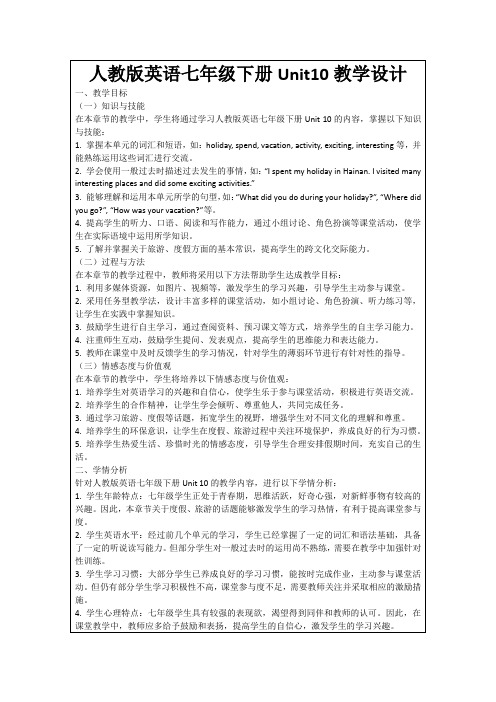
1.教师引导学生回顾本节课所学的知识点,如一般过去时的构成、用法、动词过去式变化规则等。
2.学生分享在本节课中的收获和感悟,教师给予肯定和鼓励。
3.教师强调本章节的重要性和实际应用价值,激发学生学习英语的兴趣和自信心。
4.教师布置课后作业,要求学生继续巩固一般过去时的运用,并为下一节课的学习做好准备。
难点:学生在口语表达时,如何能够自然、流畅地使用一般过去时,以及如何组织语言表达自己的旅游经历。
(二)教学设想
1.针对重难点的教学策略:
-利用多媒体教学资源,如视频、图片等,创设真实的旅游场景,让学生在情境中感知和运用一般过去时态。
-设计不同层次的教学活动,如小组讨论、个人陈述等,帮助学生从易到难地掌握一般过去时的用法。
2.采用任务型教学法,设计丰富多样的课堂活动,如小组讨论、角色扮演、听力练习等,让学生在实践中掌握知识。
3.鼓励学生进行自主学习,通过查阅资料、预习课文等方式,培养学生的自主学习能力。
4.注重师生互动,鼓励学生提问、发表观点,提高学生的思维能力和表达能力。
5.教师在课堂中及时反馈学生的学习情况,针对学生的薄弱环节进行有针对性的指导。
-完成课后练习,如填空、选择、回答问题等。
4.词汇积累:学生自主收集5个与旅游相关的词汇和短语,要求用英文解释其含义,并给出一个例句。此作业有助于扩大学生的词汇量,提高语言运用能力。
5.预习作业:预习下一节课的内容,提前了解新课中的词汇、语法点,为课堂学习做好准备。
-通过课堂互动,教师及时发现并纠正学生在时态运用上的错误,给予针对性的指导。
2.教学过程设计:
-导入新课:通过展示不同旅游目的地的图片,激发学生的兴趣,引导学生谈论自己的旅游经历,自然引入一般过去时的学习。
2020-2021学年人教版英语七年级下册Unit10SectionA(1a-1c)教案
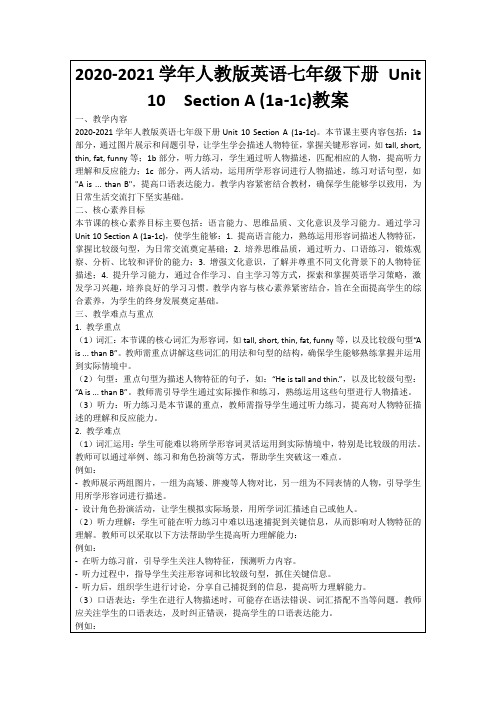
其次,在实践活动和小组讨论中,部分学生表现出词汇运用不够熟练、句型结构掌握不牢固等问题。这提示我在今后的教学中,要更加关注学生的实际操作能力,通过设计更多有针对性的练习,帮助学生巩固所学知识。同时,也要鼓励学生在课堂上多开口说英语,提高他们的口语表达能力。
二、核心素养目标
本节课的核心素养目标主要包括:语言能力、思维品质、文化意识及学习能力。通过学习Unit 10 Section A (1a-1c),使学生能够:1.提高语言能力,熟练运用形容词描述人物特征,掌握比较级句型,为日常交流奠定基础;2.培养思维品质,通过听力、口语练习,锻炼观察、分析、比较和评价的能力;3.增强文化意识,了解并尊重不同文化背景下的人物特征描述;4.提升学习能力,通过合作学习、自主学习等方式,探索和掌握英语学习策略,激发学习兴趣,培养良好的学习习惯。教学内容与核心素养紧密结合,旨在全面提高学生的综合素养,为学生的终身发展奠定基础。
四、教学流程
(一)导入新课(用时5分钟)
同学们,今天我们将要学习的是Unit 10 Section A (1a-1c)这一章节。在开始之前,我想先问大家一个问题:“你们在日常生活中是否遇到过描述人物特征的情况?”例如,介绍新朋友或者描述自己喜欢的明星。这个问题与我们将要学习的内容密切相关。通过这个问题,我希望能够引起大家的兴趣和好奇心,让我们一同探索如何用英语描述人物特征。
1.讨论主题:学生将围绕“形容词在实际生活中的应用”这一主题展开讨论。他们将被鼓励提出自己的观点和想法,并与其他小组成员进行交流。
七年级英语下册(人教版)Unit10第4课时(SectionB2a2c)教学设计
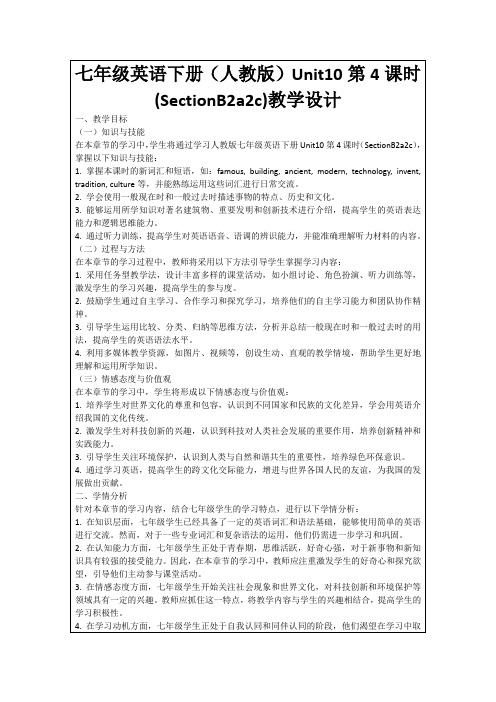
(一)教学重难点
1.教学重点:
a.掌握本课时的新词汇和短语,如:famous, building, ancient, modern, technology, invent, tradition, culture等。
b.学会使用一般现在时和一般过去时描述事物的特点、历史和文化。
b.结合研究报告,用英语进行展示和分享,提高学生的研究能力和团队合作精神。
作业布置要求:
1.学生应在规定时间内完成作业,注意作业质量,力求书写规范、表达清晰。
2.家长应鼓励和监督孩子完成作业,关注孩子的学习进度,适时给予指导和帮助。
3.教师将对学生的作业进行认真批改,及时反馈,针对学生的个体差异给予个性化指导。
3.引导学生关注环境保护,认识到人类与自然和谐共生的重要性,培养绿色环保意识。
4.通过学习英语,提高学生的跨文化交际能力,增进与世界各国人民的友谊,为我国的发展做出贡献。
二、学情分析
针对本章节的学习内容,结合七年级学生的学习特点,进行以下学情分析:
1.在知识层面,七年级学生已经具备了一定的英语词汇和语法基础,能够使用简单的英语进行交流。然而,对于一些专业词汇和复杂语法的运用,他们仍需进一步学习和巩固。
c.组织英语角活动,让学生用英语分享自己的所见所闻,提高跨文化交际能力。
四、教学内容与过程
(一)导入新课
1.教师通过展示世界各地著名建筑物的图片,如长城、埃菲尔铁塔、自由女神像等,引导学生关注建筑物的特点及其背后的文化意义。
2.邀请学生分享他们所了解的世界著名建筑物、重要发明和创新技术,激发学生对本课时话题的兴趣。
3.各小组向全班展示讨论成果,其他小组成员进行评价和提问,教师给予指导和反馈。
Unit 10 SectionB 2a-2c教案2020-2021学年人教版英语七年级下册
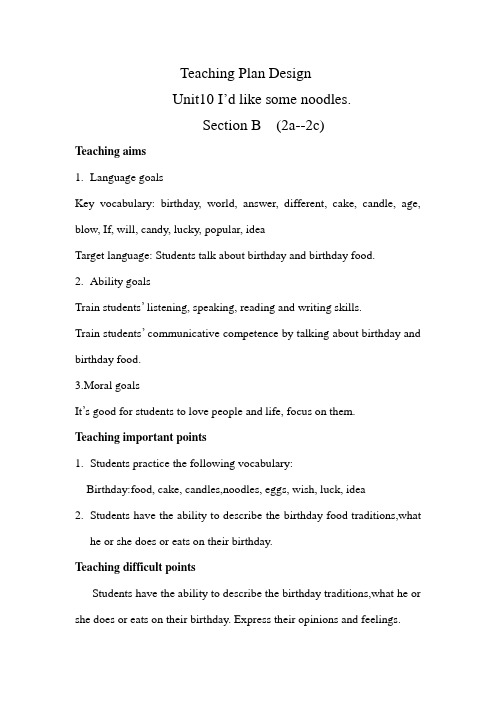
Teaching Plan DesignUnit10 I’d like some noodles.Section B (2a--2c)Teaching aimsnguage goalsKey vocabulary: birthday, world, answer, different, cake, candle, age, blow, If, will, candy, lucky, popular, ideaTarget language: Students talk about birthday and birthday food.2.Ability goalsTrain students’ listening, speaking, reading and writing skills.Train students’ communicative competence by talking about birthday and birthday food.3.Moral goalsIt’s good for students to love people and life, focus on them.Teaching important points1.Students practice the following vocabulary:Birthday:food, cake, candles,noodles, eggs, wish, luck, idea2.Students have the ability to describe the birthday food traditions,whathe or she does or eats on their birthday.Teaching difficult pointsStudents have the ability to describe the birthday traditions,what he or she does or eats on their birthday. Express their opinions and feelings.Teaching methodsTask-Based Language Teaching method: Pair work group work Teaching tools MultimediaTeaching proceduresStep1 Warming upAsk questions like this :T: When do you feel very happy and excited ?S: On my birthday.(The answers will vary)T: If you feel very happy and excited ,you’ll be a mouse.T: Do you want to know the mouse,let’s watch a video.( Multimedia )Do you think the mouse is very happy and excited? Why ?(The answers will vary)Step 2 PresentationT:When we talk about birthday,what do we think ?S:Birthday cake,song,gift,card,food......T:Look at the items,First,pay attention to birthday cake.(Put a birthday cake on the table) What birthday cakes do you like?I like the birthday cake with nuts in it.What about you?Second,pay attention to birthday food ,we’ll talk about birthday food around the world.Step 3 check preview and practice1.Let the students read the article one by one.2.Students practice the phrases in pairs.One student says the phrases in Chinese,the other says them in English. For example: birthday food,around the world,would like......3.According to the article,ask the students which sentence is difficult for them to understand.4.Learn the new items:the number of and a number of; if-conditionals.Then students practice them in the paper.5.Learn the article and students answer the questions:What do people do or eat in many countries? What’s the special meaning?What do people do or eat in China? What’s the special meaning? What other things do people do on their birthday?Step 4 Consolidation1.Watch the pictures and the videos and talk about what students do or eat on their birthday.Play the game: Guess who he or she is? What does he or she do on his or her birthday?Students can have a competition. Try to talk about them as much as they can. See which team can win.Students talk about their activities and express their feelings .Step 5 Summary and homeworkBlackboard DesignUnit 10 I ’d like some noodles.课后反思:本节课教学中明确以学生为中心,以学生发展为本,让学生积极参与到课堂教学活动中来。
人教版七年级英语下册Unit10单元教学设计
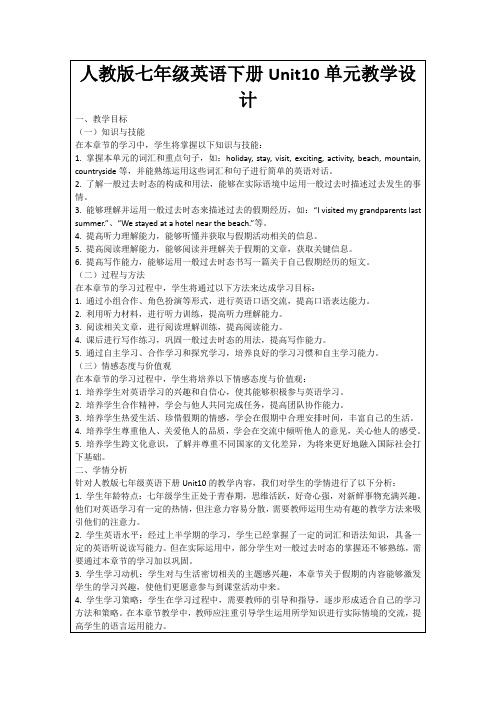
(三)学生小组讨论
在这一环节,我将组织学生进行小组讨论,以达到以下目的:
1.让学生相互交流,分享彼此的假期经历,提高口语表达能力。
-学生分组讨论,每人用英语介绍自己的假期经历,其他成员倾听并提问。
-各小组选代表进行汇报,展示讨论成果。
2.通过小组讨论,巩固一般过去时的用法,提高学生的语法应用能力。
4.词汇复习:复习本章节所学词汇,用思维导图或单词卡片的形式进行记忆。要求学生掌握单词的拼写、词义和用法。
-此作业有助于学生巩固词汇,提高词汇记忆效果。
-教师可组织词汇竞赛,激发学生的学习兴趣和竞争意识。
5.课后总结:请学生在本章节结束后,总结一般过去时态的用法、重点词汇和句型。要求用简洁明了的语言,形成笔记。
2.利用听力材料,进行听力训练,提高听力理解能力。
3.阅读相关文章,进行阅读理解训练,提高阅读能力。
4.课后进行写作练习,巩固一般过去时态的用法,提高写作能力。
5.通过自主学习、合作学习和探究学习,培养良好的学习习惯和自主学习能力。
(三)情感态度与价值观
在本章节的学习过程中,学生将培养以下情感态度与价值观:
2.了解一般过去时态的构成和用法,能够在实际语境中运用一般过去时描述过去发生的事情。
3.能够理解并运用一般过去时态来描述过去的假期经历,如:“I visited my grandparents last summer.”、“We stayed at a hotel near the beach.”等。
2.邀请学生分享自己的假期经历,鼓励他们用英语表达,为新课的学习做好铺垫。
-学生分享时,引导他们使用一般过去时描述过去的事情,如:“I went to the countryside last summer.”、“We had a picnic in the park.”等。
人教英语七下:UNit10 I’d+like+some+noodles学案
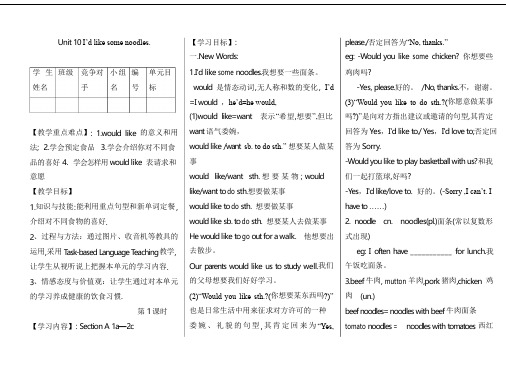
Unit10I’d like some noodles.【学习目标】:一.New Words:please./否定回答为“No,thanks.”eg:-Would you like some chicken?你想要些学生班级竞争对小组编单元目 1.I'd like some noodles.我想要一些面条。
鸡肉吗?姓名手名号标would是情态动词,无人称和数的变化,I’d-Y es,please.好的。
/No,thanks.不,谢谢。
【教学重点难点】: 1.would like的意义和用法; 2.学会预定食品 3.学会介绍你对不同食品的喜好4.学会怎样用would like表请求和意愿【教学目标】1.知识与技能:能利用重点句型和新单词定餐,介绍对不同食物的喜好.2、过程与方法:通过图片、收音机等教具的运用,采用T ask-based Language T eaching教学,让学生从视听说上把握本单元的学习内容.3、情感态度与价值观:让学生通过对本单元的学习养成健康的饮食习惯.第1课时【学习内容】:Section A1a—2c =I would,he’d=he would,(1)would like=want表示“希望,想要”,但比want语气委婉,would like/want sb.to do sth.”想要某人做某事would like/want sth.想要某物;wouldlike/want t o do sth.想要做某事would like t o do sth.想要做某事would like sb.t o do sth.想要某人去做某事He would like t o go o u t for a walk.他想要出去散步。
Our parents would like us t o study well.我们的父母想要我们好好学习。
(2)“Would you like sth.?(你想要某东西吗?)”也是日常生活中用来征求对方许可的一种委婉、礼貌的句型,其肯定回来为“Yes,(3)“Would you like to do sth.?(你愿意做某事吗?)”是向对方指出建议或邀请的句型,其肯定回答为Yes,I'd like to./Yes,I'd love to;否定回答为Sorry.-Would you like t o play basketball with us?和我们一起打篮球,好吗?-Y es,I'd like/love to.好的。
人教版英语七年级下册Unit10 Section A(2d-3c)导学案

Unit10 Section A〔2d-3c〕导学案【课型】阅读语法课【学习目标】1.能够掌握本课order,bowl,size,tofu 等词汇,运用核心句型May I take your order?-We’d like one bowl of beef soup? -Sure. What size would you like? -Large,please.等进展订餐或叫外卖活动。
2. 通过订餐对话活动让学生学会订餐和讨论饮食爱好,并在真实或模拟的语境下,运用所学的语言进展交际活动,通过语法的学习让学生能够正确运用可数名词和不可数名词、不定代词some/any和would like。
3. 能掌握订餐或叫外卖等的用语,体会学习英语的乐趣,做到“在用中学〞“在学中用〞。
学习过程【自主学习】将对话补充完整后,三人一组模拟面馆情景准备课前表演。
Waiter:?Boy: I’d like a large bowl of noodles.Waiter: And ?Boy: I’d like chicken, potato, and cabbage noodles.Waiter:?Girl: I’d like a medium bowl.Waiter:?Boy: I’d like beef and tomato noodles, please.【新课导入】Step l: Warming-up and lead-in1. Ask and answer questions with your partner, Use the formation in 2a.2. Show the conversations of 2a on the big screen to the students.3. Make a model for the students.T: What kind of noodles would you like?S: I’d like beef noodles, please....4. Students work in pairs and practice the conversation.【新知呈现】Step 2: Role-play1. Ask students to read the conversation in 2d and find the answer to this question: What would they like?(They would like one large bowl of beef soup, one gongbao chicken, and one mapo tofu with rice.)2. Check the answer with the students.3. Students work with their partners and role-play the conversation.4. Language points.【新知学习】Step 3: Grammar Focus1. 学生阅读Grammar Focus中的句子,然后做练习。
2021-2022学年人教版英语七年级下册Unit10讲练导学案第三课时
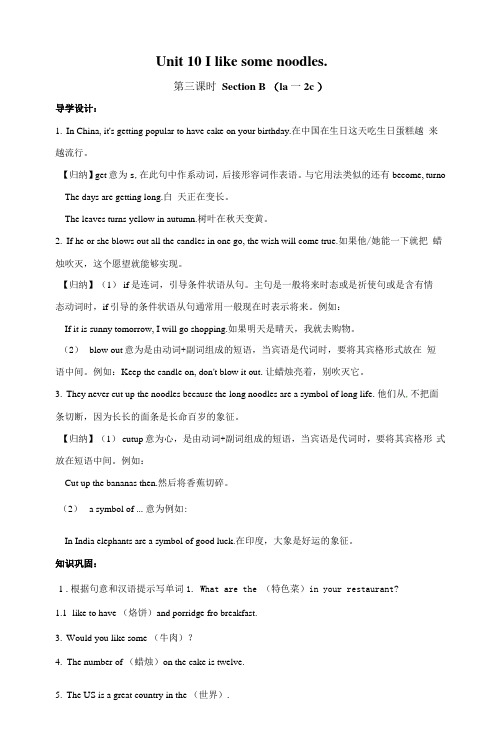
Unit 10 I like some noodles.第三课时Section B (la一2c )导学设计:1.In China, it's getting popular to have cake on your birthday.在中国在生日这天吃生日蛋糕越来越流行。
【归纳】get意为s,在此句中作系动词,后接形容词作表语。
与它用法类似的还有become, turno The days are getting long.白天正在变长。
The leaves turns yellow in autumn.树叶在秋天变黄。
2.If he or she blows out all the candles in one go, the wish will come true.如果他/她能一下就把蜡烛吹灭,这个愿望就能够实现。
【归纳】(1) if是连词,引导条件状语从句。
主句是一般将来时态或是祈使句或是含有情态动词时,if引导的条件状语从句通常用一般现在时表示将来。
例如:If it is sunny tomorrow, I will go shopping.如果明天是晴天,我就去购物。
(2)blow out意为是由动词+副词组成的短语,当宾语是代词时,要将其宾格形式放在短语中间。
例如:Keep the candle on, don't blow it out.让蜡烛亮着,别吹灭它。
3.They never cut up the noodles because the long noodles are a symbol of long life.他们从,不把面条切断,因为长长的面条是长命百岁的象征。
【归纳】(1) cutup意为心,是由动词+副词组成的短语,当宾语是代词时,要将其宾格形式放在短语中间。
例如:Cut up the bananas then.然后将香蕉切碎。
(2) a symbol of ...意为例如:In India elephants are a symbol of good luck.在印度,大象是好运的象征。
人教版七年级下英语Unit 10教案、导学案

七年级英语·下新目标【人】Unit 10 I’d like some noodles.1.可数名词与不可数名词的区分。
2.点餐时的基本句型及交际运用。
3.some与any的运用。
4.培养学生从文章中获取细节,并进行归纳总结的能力,学生养成良好的阅读习惯。
以听说领先,在英语语境中大量感知和训练本单元的表示如何点餐的句型,养成良好的学习英语的习惯。
通过单元的语言学习,归纳总结如何点餐的句型以及可数名词与不可数名词的区分,使知识的记忆系统化。
采用Pair work和Group work相结合的方式,练习在饭店点餐的英文句型。
阅读活动设计为“读前、读中、读后”,每一步都设计了不同的任务或活动,重在培养学生的阅读策略和技能, 同时结合阅读材料进行拓展性语言训练和运用。
让学生在语言学习的过程中, 了解不同国家的饮食习惯。
教学突破:创设语境,重视听说能力,反复训练如何点餐。
在练习中正确使用What kind of …?注重方法与价值观的培养:以听说领先,结合图片的帮助在英语语境中大量感知和训练本单元的各种食物的名称和有关点餐的话题,学习would like的句型,养成良好的学习英语的习惯。
通过单元的语言学习,归纳总结would like句型、some和any的用法以及可数名词和不可数名词的语法知识,使知识的记忆形象化、系统化。
采用Pair work和Group work相结合的方式,练习点餐的英文句型。
通过大量的课堂练习,让学生对谈论饮食的话题感兴趣,并能运用所学的语言进行阅读写作练习,从语言学习的过程中,了解中西方饮食文化。
第一课时:Section A 1a-1c第二课时:Section A 2a-3c第三课时:Section B 1a-2c第四课时:Section B 3a - Self Check国外餐馆就餐礼仪在国外,一般的餐馆(非快餐性质)在门口均有带位员。
顾客进门后,带位员会首先问顾客同行有几位,然后带顾客入座。
人教版初中七年级英语下册第十单元Unit10教案含教学反思

⼈教版初中七年级英语下册第⼗单元Unit10教案含教学反思第10单元I’d like some noodles.类别课程标准要求掌握的内容话题Food⾷物Section A 单词noodle n.⾯条beef n.⽜⾁potato n.⼟⾖;马铃薯would modal v.(表⽰意愿)愿意yet adv.还;仍然large adj.⼤号的;⼤的order n.& v.点菜;命令size n.⼤⼩;尺码bowl n.碗meat n.(可⾷⽤的)⾁special n.特⾊菜;特价品adj.特别的;特殊的cabbage n.卷⼼菜;洋⽩菜mutton n.⽺⾁tofu n.⾖腐短语would like愿意;喜欢take one’s order 点菜what size多⼤(尺⼨)one (large)bowl of…⼀(⼤)碗……what kind of哪⼀种……句型1.—What would you like? 您想要点什么?—I’d like some noodles. 我想要些⾯条。
2. Are there any vegetables in the beef noodles?⽜⾁⾯⾥有蔬菜吗?3. We’d also like gongbao chicken and some mapo tofu with rice.句型1. The number of candles is the person’s age.蜡烛的数量是过⽣⽇的⼈的年龄。
2. If he or she blows out all the candles in one go,the wish will come true. 如果他/她⼀⼝⽓吹灭所有的蜡烛,许的愿望便会成真。
3. They never cut up the noodles because the long noodles are a symbol of long life. 他们从不切碎⾯条,因为长长的⾯条是长寿的象征。
英语人教版七年级下册10单元教案七下
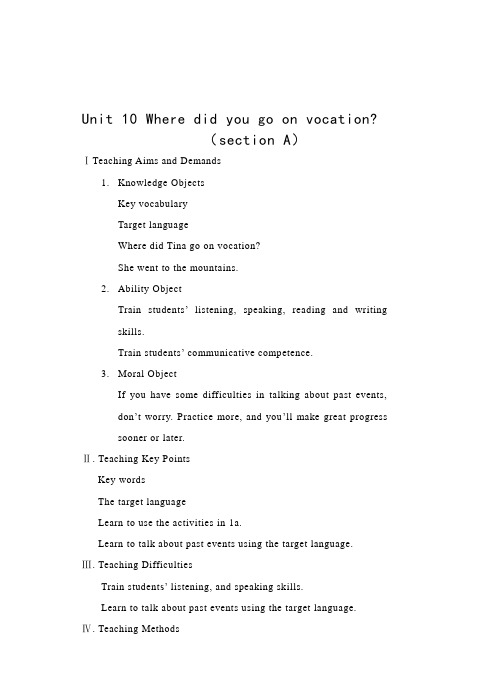
Unit 10 Where did you go on vocation?(section A)ⅠTeaching Aims and Demands1.Knowledge ObjectsKey vocabularyTarget languageWhere did Tina go on vocation?She went to the mountains.2.Ability ObjectTrain students’listening, speaking, reading and writingskills.Train students’ communicative competence.3.Moral ObjectIf you have some difficulties in talking about past events,don’t worry. Practice more, and you’ll make great progresssooner or later.Ⅱ. Teaching Key PointsKey wordsThe target languageLearn to use the activities in 1a.Learn to talk about past events using the target language.Ⅲ. Teaching DifficultiesTrain student s’ listening, and speaking skills.Learn to talk about past events using the target language.Ⅳ. Teaching MethodsScene teaching method.Listening and oral practice methods.Ⅴ. Teaching AidsA tape recorderA computerⅥ. Teaching ProceduresStepⅠGreetingGreet the class as usual.Check the homework.StepⅡ1a 1b1. Each picture shows something a person did I the past.Then ask students to name each activity.2. Play a recording of three conversations. These people aretalking about what they did on vacation. Listen and writethe numbers of the names in the boxes in the picture. StepⅢ1cWork with a partner, make conversations to talk about whatthe people in activity 1a went on vacation.StepⅣ2a 2b1. Play a recording of three conversations. These people aretalking about where they went on vacation. You are to listenand match the person with the place.2. Play the same recording again. Put a check mark under theheadline ” Yes, I did.” or “ No, I don’t.”StepⅤ2c Grammer Focus1. Place students into groups of three. Suppose one of you isNancy, one is Kevin and one is Julie. Now please ask eachother questions to talk about where you went on vacation asin the sample conversation.2. Ask students to read the questions and answers in pairs. StepⅥ3a 3bFill in the blanks with the word “was “ or “were” .Look at the pictures carefully and try to describe each one. StepⅦ 4Works in groups and talk about their photos.StepⅧSummarySummary the target language we’ve learned in this class. StepⅨHomeworkWrite a short passage to talk about one of your vacations.Blackboard DesignUnit 10 Where did you go on your vacation?(section B)ⅠTeaching Aims and Demands1.Knowledge ObjectsKey words.Target language.2.Ability ObjectTrain students’ listening, speaking, reading and writingskills.Train students’ communicative competence.Self-check.3.Moral ObjectⅡ. Teaching Key PointsThe key vocabulary.The target language.Ⅲ. Teaching DifficultiesTrain students’ reading and writing skills.Write a travel diary.Complete a questionnaire and make a survey.Ⅳ. Teaching MethodsListening, reading, writing and speaking methods.Practicing methodsGroup workⅤ. Teaching AidsA computerThe blackboard.Ⅵ. Teaching ProceduresStepⅠGreetingGreet the class as usual.Check the homework.StepⅡ1a 1b1. Point out the numbered list of words in the box. Read themand have students repeat several times.2. Ask, which words are happy words and which are unhappyones? Please put them in the correct blanks.StepⅢ2a 2b1. Listen to a conversation. Vera is talking about her vacation.Please listen and answer the question.2. Play the same recording again. You are to listen and writedown the answers to these things.StepⅣ2cStudent A is Vera’s friend and Student B is Vera. Get studentto role play the conversation in pairs.StepⅤ3a 3b1. Read the diaries carefully by yourselves. Circle the goodthings about the vacation and underline the bad things.2. Imagine you are an American student on vacation in Beijing.Please write a travel diary.StepⅥ 4Place students into groups of five. Imagine you are allforeigners on vacation in China. Take turns telling whatyou did on your vacation.StepⅦSelf-check 1 2 31. Ask students to check all the words they know.2. Ask students to write five new words in theirVocab-builder.3. Help students to make up questions about the topics in theform. Write the questions on a piece of paper.StepⅧSummarySummary the target language we’ve learned in this class. StepⅨHomeworkChoose the most interesting place you have ever been to and write a travel diary.Blackboard Design教学后记:Unit 10 Where did you go on your vacation?复习教案ⅠTeaching Aims and Demands4.Knowledge ObjectsReview to talk about past tense.5.Ability ObjectImprove students’ ability of listening, speaking, readingand writing skills.Improve students’ ability of communicative competence.6.Moral ObjectIf you have time, go to somewhere you like to have a goodtime. Not only will you enjoy the beauty of our country, youwill also feel better.Ⅱ. Teaching Key PointsThe key vocabularyThe target languageReview to talk about your vacations and describe them.Ⅲ. Teaching DifficultiesTrain students’ competence abilityⅣ. Teaching MethodsPairworkPracticing methodsⅤ. Teaching AidsA computerCardsⅥ. Teaching ProceduresStepⅠTalk about past eventsWrite a travel diaryGet students to write their own diary on an extra piece of paper. Encourage students to use a dictionary for some new words.Get the students who finished the writing first to write his or hers in the blackboard. Correct any spelling and grammar mistakes with the students.StepⅡReview the target languageWhere did you go on vacation?We went to New York.Did you go to Central Park?Yes, I did.How was the weather?It was humid.StepⅢReview the structureReview Past tense of regular and irregular verbs: was/were. StepⅣReview the key vocabularyWere, stayed, visited, felt, expensive, cheep, crowded, deliciousAfter reviewed these words, then have a dictation.StepⅤSummarySummary the target language we’ve reviewed in this unit. StepⅥHomeworkReview the target language and the key words in this unit.Blackboard Design教学后记:。
2020-2021学年人教版英语七年级下册Unit10教案

1.理论介绍:首先,我们要了解一般现在时态的基本概念。一般现在时态是描述习惯性动作或普遍真理的时态。它是英语学习中的基础时态,非常重要。
2.案例分析:接下来,我们来看一个具体的案例。这个案例展示了如何用一般现在时态描述日常活动,以及它如何帮助我们表达习惯性的行为。
3.重点难点解析:在讲授过程中,我会特别强调一般现在时态的构成和频率副词的使用这两个重点。对于难点部分,我会通过举例和比较来帮助大家理解。
五、教学反思
在Unit 10《Daily Life》的教学过程中,我注意到了几个值得反思的方面。首先,学生在掌握一般现在时态的疑问句构成上存在一定难度,这说明我在这一部分的教学可能需要更加细致和具体。我考虑在下一节课通过更多实际例句和互动提问,帮助学生更好地理解和运用疑问句。
其次,实践活动中的角色扮演活动,学生们表现得相当积极,这让我感到欣慰。但同时我也注意到,有些学生在口语表达上仍显得不够自信和流畅。为了提高他们的口语能力,我计划在接下来的课程中增加更多类似的活动,鼓励他们多开口说英语,增强信心。
-语法结构在真实语境中的应用:学生需要理解何时使用一般现在时态,并能在真实的交际情境中正确运用。
-阅读理解中的细节抓取:在阅读过程中,学生可能会在理解文章细节和推断作者意图时遇到困难。
-词汇的拼写和用法区分:某些词汇可能拼写相似,但用法不同,如get up与get on,学生需要区分记忆。
在教学过程中,教师应针对以上难点和重点进行有针对性的讲解和练习,通过实例、图表、游戏等多种教学活动,帮助学生透彻理解并掌握这些知识。
2. Section B:继续深化日常活动话题,引入一般现在时态的疑问句和否定句。
-学习疑问词:What time, How often。
2020-2021学年人教版英语七年级下册Unit 10 复习导学案(无答案)
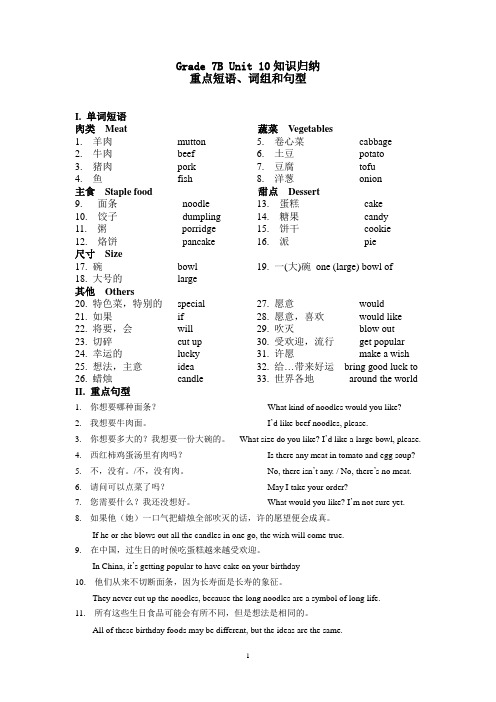
Grade 7B Unit 10知识归纳重点短语、词组和句型I. 单词短语肉类Meat 蔬菜Vegetables1. 羊肉mutton2. 牛肉beef3. 猪肉pork4. 鱼fish5. 卷心菜cabbage6. 土豆potato7. 豆腐tofu8. 洋葱onion主食Staple food 甜点Dessert9. 面条noodle10. 饺子dumpling11. 粥porridge12. 烙饼pancake 13. 蛋糕cake14. 糖果candy15. 饼干cookie16. 派pie尺寸Size17. 碗bowl18. 大号的large19. 一(大)碗one (large) bowl of 其他Others20. 特色菜,特别的special21. 如果if22. 将要,会will23. 切碎cut up24. 幸运的lucky25. 想法,主意idea26. 蜡烛candle 27. 愿意would28. 愿意,喜欢would like29. 吹灭blow out30. 受欢迎,流行get popular31. 许愿make a wish32. 给…带来好运bring good luck to33. 世界各地around the worldII. 重点句型1.你想要哪种面条?What kind of noodles would you like?2.我想要牛肉面。
I’d like beef noodles, please.3.你想要多大的?我想要一份大碗的。
What size do you like? I’d like a large bowl, please.4.西红柿鸡蛋汤里有肉吗?Is there any meat in tomato and egg soup?5.不,没有。
/不,没有肉。
No, there isn’t any. / No, there’s no meat.6.请问可以点菜了吗?May I take your order?7.您需要什么?我还没想好。
新人教版七年级下册英语Unit10导学案
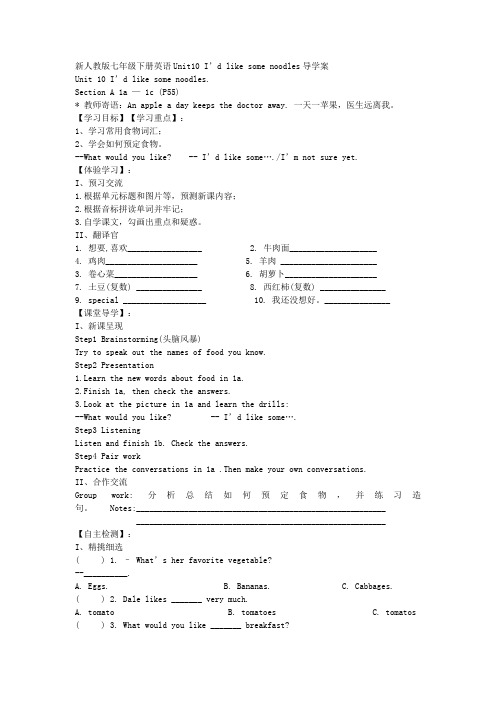
新人教版七年级下册英语Unit10 I’d like some noodles导学案Unit 10 I’d like some noodles.Section A 1a — 1c (P55)* 教师寄语:An apple a day keeps the doctor away. 一天一苹果,医生远离我。
【学习目标】【学习重点】:1、学习常用食物词汇;2、学会如何预定食物。
--What would you like? -- I’d like some…./I’m not sure yet.【体验学习】:I、预习交流1.根据单元标题和图片等,预测新课内容;2.根据音标拼读单词并牢记;3.自学课文,勾画出重点和疑惑。
II、翻译官1. 想要,喜欢_________________2. 牛肉面____________________4. 鸡肉_____________________5. 羊肉 ______________________3. 卷心菜___________________ 6. 胡萝卜_____________________7. 土豆(复数) _______________ 8. 西红柿(复数) _______________9. special ___________________ 10. 我还没想好。
_______________【课堂导学】:I、新课呈现Step1 Brainstorming(头脑风暴)Try to speak out the names of food you know.Step2 Presentation1.Learn the new words about food in 1a.2.Finish 1a, then check the answers.3.Look at the picture in 1a and learn the drills:--What would you like? -- I’d like some….Step3 ListeningListen and finish 1b. Check the answers.Step4 Pair workPractice the conversations in 1a .Then make your own conversations.II、合作交流Group work: 分析总结如何预定食物,并练习造句。
2020-2021学年七年级英语电子导学案:Unit-10-第四课时
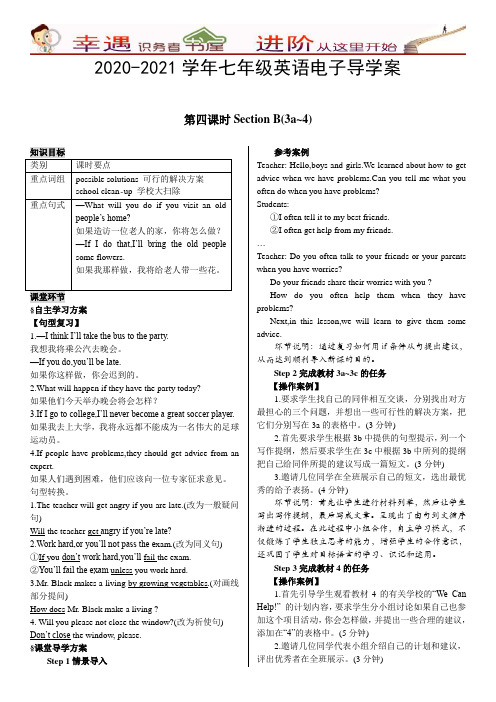
2020-2021学年七年级英语电子导学案第四课时Section B(3a~4)知识目标类别课时要点重点词组possible solutions 可行的解决方案school clean-up 学校大扫除重点句式—What will you do if you visit an oldpeople’s home?如果造访一位老人的家,你将怎么做?—If I do that,I’ll bring the old peoplesome flowers.如果我那样做,我将给老人带一些花。
课堂环节§自主学习方案【句型复习】1.—I think I’ll take the bus to the party.我想我将乘公汽去晚会。
—If you do,you’ll be late.如果你这样做,你会迟到的。
2.What will happen if they have the party today?如果他们今天举办晚会将会怎样?3.If I go to college,I’ll never become a great soccer player.如果我去上大学,我将永远都不能成为一名伟大的足球运动员。
4.If people have problems,they should get advice from an expert.如果人们遇到困难,他们应该向一位专家征求意见。
句型转换。
1.The teacher will get angry if you are late.(改为一般疑问句)Will the teacher get angry if you’re late?2.Work hard,or you’ll not pass the e xam.(改为同义句)①If you don’t work hard,you’ll fail the exam.②You’ll fail the exam unless you work hard.3.Mr. Black makes a living by growing vegetables.(对画线部分提问)How does Mr. Black make a living ?4. Will you please not close the window?(改为祈使句) Don’t close the window, please.§课堂导学方案Step 1情景导入参考案例Teacher: Hello,boys and girls.We learned about how to get advice when we have problems.Can you tell me what you often do when you have problems?Students:________________________①I often tell it to my best friends.②I often get help from my friends.…Teacher: Do you often talk to your friends or your parents when you have worries?Do your friends share their worries with you ?How do you often help them when they have problems?Next,in this lesson,we will learn to give them some advice.环节说明:通过复习如何用if条件从句提出建议,从而达到顺利导入新课的目的。
人教版英语七下Unit10SectionB(1a1d)教学设计

针对不同学生的学习需求,设计难易程度不同的练习,使每个学生都能在课堂上得到有效的训练。
4.听力训练,提高听力技巧
5.口语表达,增强自信
创设真实的语言环境,鼓励学生大胆开口,进行模仿、角色扮演等口语练习。同时,教师应及时给予鼓励和正面反馈,提高学生的自信心。
6.拓展延伸,巩固提高
人教版英语七下Unit10SectionB(1a1d)教学设计
一、教学目标
(一)知识与技能
在本章节的学习中,学生将通过学习人教版英语七下Unit10 Section B(1a-1d)的内容,掌握以下知识与技能:
1.掌握本节课的核心词汇,如: cleanliness, sweeping, washing, room, homework, exercise, habit等,并能正确运用这些词汇进行交流。
本章节的学习对象为七年级下学期的学生,他们经过前一阶段的学习,已经具备了一定的英语基础,能够运用简单的词汇和句型进行交流。在此基础上,学生们对于一般现在时态的掌握程度较好,但部分学生在运用频率副词和描述日常习惯时仍存在一定困难。此外,学生的听说能力有待提高,部分学生存在听力理解困难和口语表达不自信的问题。
2.教学方法:采用直观教学法,通过图片的展示,激发学生的兴趣和好奇心,引导学生进入本节课的主题。
3.教学目标:让学生初步了解本节课要学习的日常习惯相关词汇,为新知识的学习做好铺垫。
(二)讲授新知
1.教学内容:本节课的核心词汇(cleanliness, sweeping, washing, room, homework, exercise, habit等)和一般现在时态的运用。
4.关注学生的情感需求,鼓励他们积极参与课堂活动,培自信心,提高学习兴趣。
2020年春人教新目标英语七年级下册unit10全单元学案设计(无答案)

2020年春人教新目标英语七年级下册Unit 10 I’d like some noodlesSection A (1a—2c)[学习目标]1. 学会有关食物的新单词及点餐时所用到的新单词。
2. 学会使用would you like去询问他人的喜好。
3. 学会简单表述自己的点餐内容.[重点难点]1.学会使用would you like去询问他人的喜好。
2.学会简单表述自己的点餐内容.[学法指导] 自学—检测---合作—展示[知识链接]如何预定食物。
--What would you like? -- I’d like some…./I’m not sure yet.[学习过程]一、创设情境,呈现目标1、学习常用食物词汇;2、学会如何预定食物。
--What would you like? -- I’d like some…./I’m not sure yet.二、自学探究,交流展示任务一:检测预习单词;1.Look at the pictures and speak out the words.2.Write down the words :1.特色菜___________2. 想要_________3.大号的_________4.小号的_______5.中号的___________6.碗__________7.大小、尺码________8. 一大碗_______任务二:New sentences1.Kinds of noodles :beef and tomato noodles 牛肉西红柿面mutton and potato noodles 羊肉土豆面chicken and cabbage noodles 白菜鸡肉面2.Drills:What kind of noodles would you like?I’d like ...3.Sizes:(1)a _______(小) bowl (of noodles )a _________ (中号的) bowl (of noodles )a __________(大号的) bowl (of noodles)(2)What size would you like?I ’d like a small bowl (of noodles),please4.Pair workA: What kind of noodles would you like?B: I’d like mutton and potato noodles, please.A: what size would you like?B: I’d like a small/medium/ large bowl , please.任务三:Section A 1a Match the words with the foods.任务四:Listening 1b -2b三、难点释疑,延伸拓展:1. A: What would you like? 您需要什么?B: I’m not sure yet. 我还没想好。
- 1、下载文档前请自行甄别文档内容的完整性,平台不提供额外的编辑、内容补充、找答案等附加服务。
- 2、"仅部分预览"的文档,不可在线预览部分如存在完整性等问题,可反馈申请退款(可完整预览的文档不适用该条件!)。
- 3、如文档侵犯您的权益,请联系客服反馈,我们会尽快为您处理(人工客服工作时间:9:00-18:30)。
英语导学案(七年级下)编号编制人
【学习目标】
1. 1) 继续练习运用如何订餐或叫外卖等的用语。
2) 根据所提供的材料能运用所学的知识来补全对话。
3) 总结复习订餐时所用句型结构。
2. 情感态度价值观目标:
体会学习英语的乐趣,做到“在用中学”“,在学中用”。
养成一个良好的饮食习惯。
【学习重点】1. 教学重点:1) 总结订餐所用语言及句子结构。
2) 学习理解情态动词would 的用法。
3) 通用所学的知识在实际情境中订餐。
2. 教学难点:1) 在较为真实的订餐语境中会运用学过的语言知识来补全对话。
2) 能掌握订餐的用法,并在实际情境中运用。
【预习案】
1.根据Grammar Focus, 归纳Section A部分语法重点;
2.自学课文,勾画出重点和疑惑。
I.选择最佳答案。
【快乐链接】 Riddle (谜语) --- 打食物名
1.What kind of dog doesn’t bite or bark?--- _______________
2.What is the smallest room in the world?---
3.What table is in the field?--- _______________
4.What stays hot even if put it in a fridge?---pepper
5.What is the only vegetable that will make you cry?--- _______________
6. My first letter is in "tea", not in "sea". My second letter is in "those", not in "these" My third letter is in "fine", not in "nine" My forth letter is in "buy", not in"boy". ---。
